
JSR Group's "E2 Initiative™" is a clear and important concept of "environmental value creation" that we constantly have in mind as we manufacture our products and develop our business. It is also used as a concept that allows us to work toward solving problems in environmental burden, resources, and climate change when we carry out our business activities.
Because both humans and innumerable other living things share this planet Earth, we must make an earnest effort to deal with environmental issues. JSR Group has adopted its E2 Initiative™ as a concept to simultaneously reduce environmental impact and create new business opportunities using the environmentally-friendly aspects of our products.
The E2 Initiative™ is based on "Eco-Innovation," which is designed to create business opportunities based on the environment, and "Energy Management," which is focused on reducing CO2 emissions. It is a concept that allows us to create value both in active and passive ways. As we shifted our concept of value from the conventional two approaches of "differentiation" and "cost," our new concept of "environmental performance" has become essential.
By using the "Life Cycle Assessment (LCA)" to evaluate the "environmental impact" of our products from the design stage in the product development to the use of the product, we are working to solve environmental problems throughout business operations.
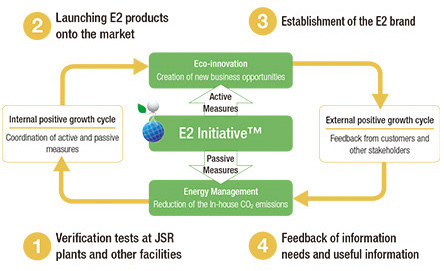
LCA (Life Cycle Assessment) is a method of quantitative assessing the environmental impact of products throughout the life cycle of each product, from the materials procurement stage to manufacturing, sales, use, and disposal.

Implementation of LCA requires that we calculate the amount of resources used when manufacturing a product and the amount of CO2 mission during all stages of the life cycle of a product (LCI data).
The entire synthetic rubber industry, including JSR Group, has engaged in LCI data calculations for representative synthetic rubber products.
The results of these calculations are stored in a database maintained by the Japan Environmental Management Association for Industry LCA Forum. For LCI data of our digital solutions products, we keep track of the amount of CO2 produced during the production.
We have started to apply LCA from the R&D stage and to operate a system of developing product designs with consideration for CO2 emissions. We have made trial LCA calculations for 55 product groups (95 representative grade types) as of March 31, 2018.
We continue to make LCA calculations for newly developed product groups and grades.
Fuel-efficient tires are environmentally-friendly products and yet maintain their ability to stop safely and securely. JSR Group's solution polymerization SBR (SSBR) has received positive feedback from customers. JSR Group designed SSBR using technology that more readily facilitates rubber molecules and tire reinforcing material molecules to bond tightly, which reduces internal friction and rolling resistance.* In addition, this is achieved without changing the characteristics of rubber that enable tires to stop. SSBR allows large reductions in environmental impact through the entire lifecycle of the tire, from the material selection and its usage to disposal.
Automobiles will still require tires even after automotive engines are replaced with electric motors. Thus, demand for SSBR is high both in countries and regions where environmental standards are high, such as Japan and Europe, and in emerging nations where reducing environmental impact is an urgent issue. SSBR is currently manufactured in two countries: At the Yokkaichi Plant in Japan and JSR BST Elastomer in Thailand. Additionally, production is scheduled to start at JSR MOL Synthetic Rubber in Hungary in 2018. We will continue helping to solve global environmental issues by meeting the global demand for fuel-efficient tires.
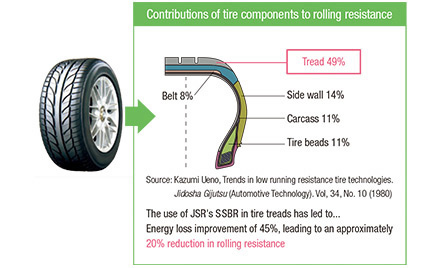
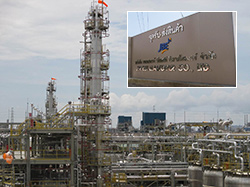
JSR BST Elastomer Co., Ltd. (Thailand)
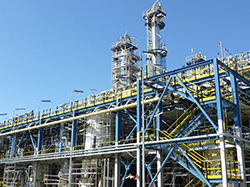
JSR MOL Synthetic Rubber Ltd. (Hungary)
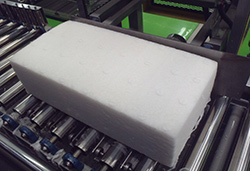
SSBR before packing
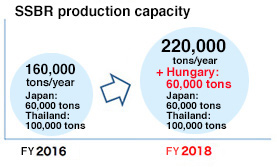
* Rolling resistance: Resistance in the direction opposite to the direction of tire rotation. Caused by tire deformation, ground contact friction, and air resistance.
JSR maintains research centers and laboratories for the Elastomers Business and Digital Solutions Business (Semiconductor Materials, Display Solution, etc.) in the Yokkaichi Plant. With the arrival of JSR's 60th anniversary in 2017, we began operations at a new type research building, one that is in addition to these facilities, with a view to further growth in the future.
There are five R&D bases within the Yokkaichi Plant: The Performance Polymer Research Laboratories, which is associated with the Elastomers Business, and the Display Solution Research Laboratories, Fine Electronic Materials Research Laboratories, Advanced Materials Research Laboratories, and Edge Computing Research Laboratories, which are associated with the Digital Solutions Business. The new research building will primarily focus on research oriented toward generating new business. For this reason, it will set research themes that anticipate market needs and enable a flexible research system that is highly responsive to customer demand based on close collaboration with the five research centers and laboratories. Moreover, to improve our ability to create innovation, which is the source of JSR's competitiveness, we will give it an environment that produces spontaneous conversation and collaboration among diverse fields, making it a base for functional interaction among individual research centers and laboratories. We will also study its application in externally-linked research activity as a base for open innovation.
We will promote "cross-field interaction among research centers and laboratories" and "interorganizational team-building" by establishing free-address offices and interactive spaces for the first time in a JSR research facility. The third-floor administrative office is a free-address office without fixed seating. Near the third-floor office, we set up spaces for personnel interaction by adjusting the floor height to create mezzanine-like floors (Floor 2.5, Floor 3.5, and Floor 4.5) and give employees the freedom to choose where they want to work.
Name: Center of Materials Innovation
Location: 100 Kawajiri-cho, Yokkaichi-chi, Mie (within the JSR Yokkaichi Plant)
Total floor space: 7,286 m2
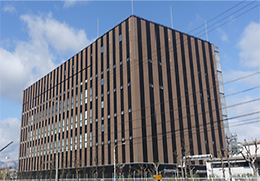
New research building: Exterior
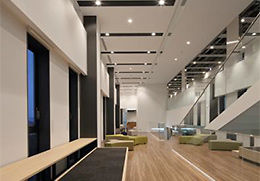
New research building: Space for interaction
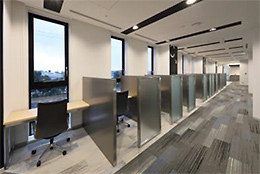
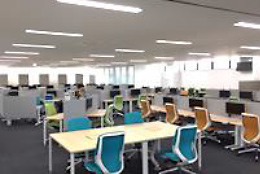
New research building: Free-address office
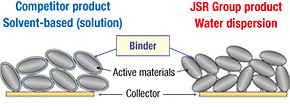
JSR Group offers electrode binders (adhesive) for lithium-ion secondary batteries. These binders have experienced an increase in demand due to efforts for the effective use of energy and the creation of a low-carbon society.
Lithium-ion secondary batteries are used in hybrid and electric vehicles. As with normal dry-cell batteries, these batteries have positive and negative electrodes.
These electrodes are made by bonding carbon materials or metal oxide particles, which function as the activating material, to copper or aluminum foil (collector). Binders provided by JSR Group are used in this binding process.
JSR Group binders are made by dispersing resin in water, which has a low environmental impact. This point bonding method also significantly reduces the bonding area of the resin that interferes with the electrical continuity of the active substance. This results in the creation of electrodes with low electrical resistance.
These electrodes demonstrate the superior performance of JSR Group polymer design technologies, water dispersion technologies, and battery performance evaluation technologies.
Not limited to electric vehicles, our materials are used in a wide variety of products including computers, cellphones, electric vacuum cleaners, and so on.

Laminated cells

Laminated-cell modules
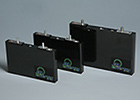
Square cells
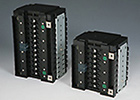
Square-cell modules
Lithium-ion capacitors, which JSR Group positioned as one of its strategic businesses in the JSR2016 mid-term business plan, are an electricity storage device capable of instant charging and discharging together with a long lifespan and little propensity for self-discharge. They are currently at the center of global attention as a key technology for the more efficient use of energy, and their market is expected to expand significantly.
JM Energy Corporation, the industry's leading company, commenced the world's first high volume production of lithium-ion capacitors at the end of 2008. The company's current aim is to develop and offer lithium-ion capacitors with higher performance by utilizing JSR Group's material and precision processing technologies to expand their applications to various fields.
Laminate cells are thin, lightweight, compact, and have excellent heat radiation. Due to their ease of installation, they can be used in a wide range of applications. A module is a package of multiple cells.
Can-type modules have superior robustness. JM Energy adopted the world's first prismatic can structure as an alternative to the more common cylindrical structure. These modules excel in heat radiation efficiency and ease of implementation.
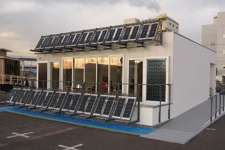
Next-generation housing developed by the University of Tokyo (CALGRIP™ used in ceilings and floors)
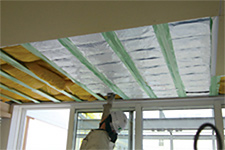
CALGRIP™ being installed in a ceiling
JSR Group's latent heat storage material CALGRIP™ is a material that is able to maintain a specific temperature between -20 and +80℃ over long periods of time. CALGRIP™ is utilized in fields that require energy saving or accurate temperature control such as the transportation and storage of pharmaceuticals and foods, building materials, and air conditioning.
The product was used in next generation energy-saving model houses developed by the University of Tokyo and Chiba University and exhibited at the "ENEX2014/Smart Energy Japan 2014" exhibition held at Tokyo Big Sight. In the University of Tokyo's model house, CALGRIP™ was installed in the ceilings and floors, storing solar radiation heat during the daytime and discharging it during the night to maintain a comfortable room temperature even in the winter. CALGRIP™ contributes to the reduction of energy consumption by minimizing the use of air conditioners/heaters.
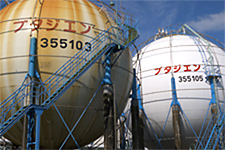
SIFCLEAR™ is used on the right butadiene tank at the Kashima Plant.
JSR Group's water-based, stain-resistant, and durable emulsion material SIFCLEAR™ is used in paints to make them resistant to contamination, helping maintain cleanness in appearance over the long-term. The high durability of the paint film reduces the need for frequent re-painting, contributing to resource conservation. In particular, when used in heat reflection paints, heat reflection effect is maintained over the long-term, achieving significant energy savings. It is also attracting attention as an environmentally-friendly material because of its ability to prevent Volatile Organic Compounds (VOCs) and the generation of odor.
As the miniaturization of transistors and wiring in IC chips continues to advance, demand for high-performance equipment used to build IC chips during semiconductor mounting processes continues to increase. JSR, IBM Japan, and Senju Metal Industry Co., Ltd. have worked together to develop a revolutionary injection molded solder (IMS) process that enables advanced high-density semiconductor mounting processes.
IMS is a technology in which a specialized soldering device directly injects solder into the opening of mask resist material formed on substrates. The mask resist material developed by JSR can resist temperatures up to approximately 250℃, which is the temperature at which solder is used. This enables extremely fine solder bump*3 patterns of 30 microns to be formed anywhere on substrates.
This eliminates the significant amount of plating required with conventional electrodeposition methods, the corresponding maintenance, and the large amount of waste disposal. With a 100% utilization ratio of solder, this environmentally friendly process generates zero process inefficiency and reduces waste products. In comparison with conventional methods, this method simplifies processes and has low environmental impact, and so we hope that this method will be utilized more and more.
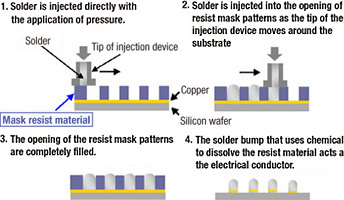
Solder bump forming process using injection molding
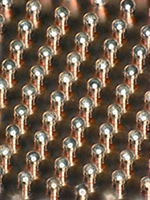
Finished solder bumps (bump diameter: 50 microns)
*2 Mask (photo) resist material: Resin for which solubility changes with light. Patterns can be formed by applying this material to wafers and then exposing it to light and developing it with chemicals. This material protects the wafer surface.
*3 Bump: A protrusion of solder that acts as an electrode to electrically connect the semiconductor device to the substrate.
HUSHLLOY™*4, a product of JSR Group's Techno-UMB Co., Ltd., has revolutionary effects in reducing the squeak noise caused by plastic joints in vehicle interiors.
Ordinarily, squeak prevention is achieved by applying grease or attaching felt fabric to plastic car parts. However, the use of HUSHLLOY™ makes these countermeasures unnecessary, allowing component manufacturers to shorten their production process and save energy. In addition, since the material itself has the effect of minimizing squeak noise, maintenance is not required for a longer period of time.
*4 HUSHLLOY™ is a registered trademark of Techno-UMG Co., Ltd.
"JSR FUELOCK" is suitable as a hose material for cars that run on bioethanol gasoline because it demonstrates superior performance with that fuel.
If a car is run on bioethanol produced from the starch of a crop that was produced from a plant's photosynthesis using the sun's energy and carbon dioxide in the air, its carbon dioxide corresponding to the plant's photosynthesis becomes zero (i.e., the car becomes so-called "carbon neutral").
"JSR FUELOCK" is helping make bioethanol gasoline cars more popular and is therefore useful as an indirect means of combatting global warming.